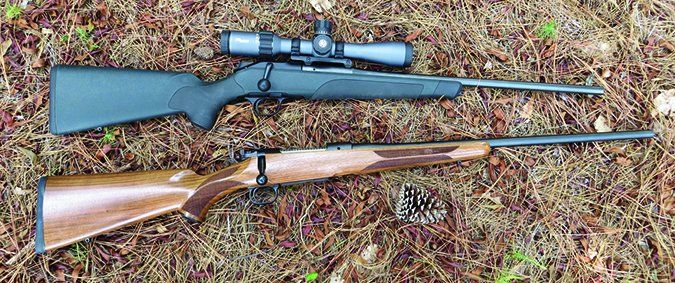
Germany has always been a leader in firearms development both for military and sporting use. The country also has a rich history of hunting. We wanted to take a look at two rifles with Teutonic hunting heritage, so we asked our dealers to wrangle up a Mauser M12 and Blaser R8. If there ever was an iconic bolt-action rifle on both sides of the Atlantic, it is the Mauser. Since 1871, Mauser has produced countless military and sporting bolt-action rifles. Mauser M98 rifles have been copied by many other rifle makers. Hallmark Mauser design features, like the action, three-position safety, and internal box magazine are built into rifles made by companies like Rigby, Winchester, CZ, Kimber, and others. The M12, however, is not a control-feed bolt action but is actually a push-feed bolt like a Remington, Sako, Weatherby, and others.
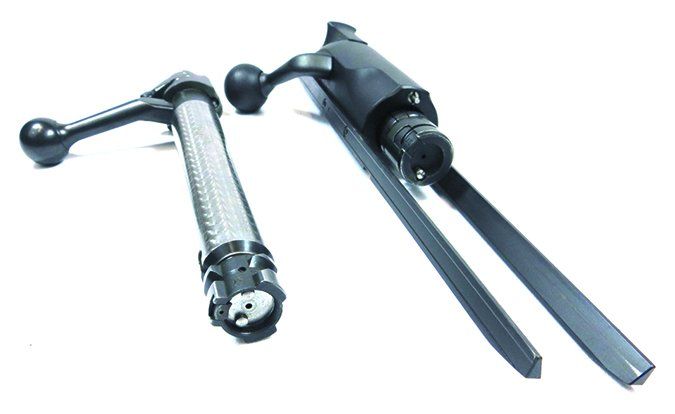
The Blaser (pronounced BLAH-zer) is a unique take on the bolt-action rifle because it uses a straight-pull bolt and offers interchange barrels in a range of calibers for gophers to elephants. Blaser had made a name for itself as an innovator of luxury hunting rifles, and though it could be debated that this German rifle is over engineered, we found some innovative features on a hunting rifle we didn’t know we needed or wanted.
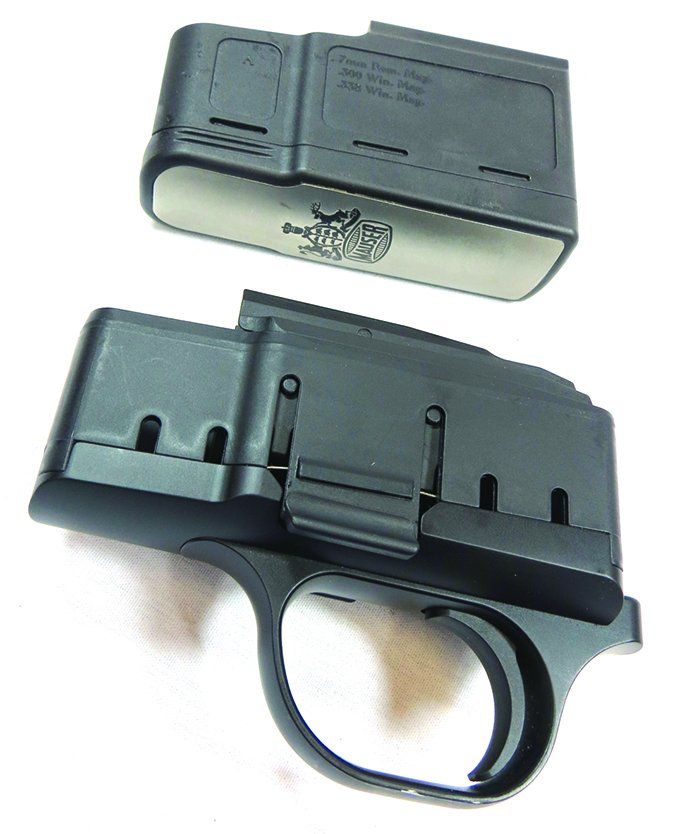
Either rifle would make an excellent deer rifle, we found, as well as top choices to take black bears, wild pigs, speed goats, and other hooved North American game. They both performed well in operation and in accuracy and after spending quality time with them, we can see why they command such a high price.
Both rifles were chambered in 30-06 Springfield, which is the benchmark caliber for American hunting cartridges. Our testers have a lot of experience with the cartridge, and we suspect that every bolt-action hunting rifle currently sold in the U.S. is available in 30-06. The round is versatile, easily found in stores, offers a range of bullet types and weights, and is at the upper level of tolerable recoil, especially when shooting the round out of lightweight hunting rifles. Both of these rifles hovered at seven pounds unscoped. For ammo in this test, we used Black Hills Gold loaded with a 180-grain Nosler AccuBond bullet and two hunting rounds from Hornady: Full Boar with a 165-grain GMX bullet and American Whitetail with a 150-grain InterLock bullet.
30-06 Springfield Range Data
| Black Hills Gold 180-gr. Nosler AccuBond | Mauser M12 | Blaser R8 Professional |
| Average velocity | 2594 fps | 2588 fps |
| Muzzle energy | 2690 ft.-lbs. | 2677 ft.-lbs. |
| Smallest group | 0.59 in. | 0.65 in. |
| Average group | 1.02 in. | 0.77 in. |
| Hornady Full Boar 165-gr. GMX | ||
| Average velocity | 2715 fps | 2807 fps |
| Muzzle energy | 2701 ft.-lbs. | 2887 ft.-lbs. |
| Smallest group | 0.32 in. | 1.45 in. |
| Average group | 0.78 in. | 1.5 in. |
| Hornady American Whitetail 150-gr. InterLock | ||
| Average velocity | 2760 fps | 2772 fps |
| Muzzle energy | 2538 ft.-lbs. | 2605 ft.-lbs. |
| Smallest group | 0.98 in. | 1.10 in. |
| Average group | 1.08 in. | 1.12 in. |
| To collect accuracy data, we fired 3-shot groups from a bench using a rest. Distance: 100 yards with optics. We recorded velocities using a ProChrono digital chronograph set 15 feet from the muzzle. | ||
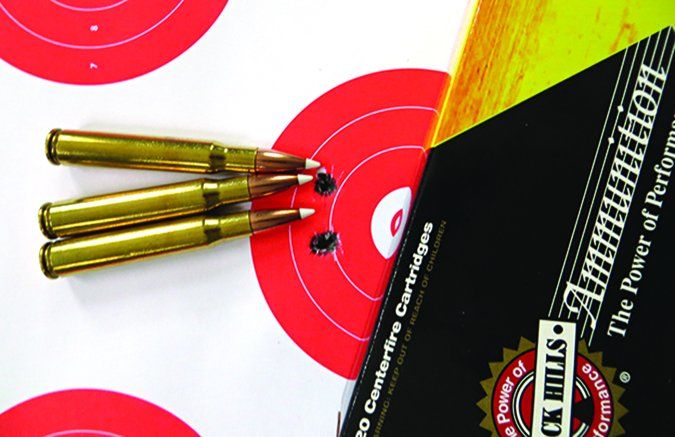
We mounted the rifles with the same optic, a SIG Tango6 2-12x40mm ($1600; Cheaper Than Dirt). This is a first focal plane-reticle scope, so the reticle increases and decreases in size as the magnification is increased or decreased. Testers liked this FFP scope because the milling reticle can be used at any magnification to estimate range. The Tango6 is equipped with an illuminated MOA Milling reticle. We could adjust reticle illumination as needed, and if we forgot to turn it off, the scope automatically turns off the illumination after six minutes of rest and powers back on as soon as it senses motion. We would have liked a parallax adjustment knob to really fine-tune the reticle, since we noticed the reticle moved ever so slightly as we moved our head and eye. Not a lot of movement, but enough to note. The scope also features Zerolock turrets, which means you can’t lose zero if you rotate the turrets too much in either direction. Turret dials need to be pulled out to make adjustments then pushed back. Adjustments could be felt and seen easily, so getting our dope was simple after bore sighting. All adjustments were clearly marked, which we liked. The magnification ring used two fiber-optic dots that glowed to give the user a heads up on the magnification the scope was set at. Turrets and the magnification ring were toothy, with lots of texture, so rotating the dials was effortless. We could adjust the reticle easily while looking at it on target. For mid-range and typical hunting distances, we think the SIG scope would be a fine choice on these rifles. Where the bullet hits the paper is the real test of how well these rifles will do in the game field and deer stands. Here are the details on these luxury game getters.
Mauser M12 30-06 Springfield, $1799
GUN TESTS GRADE: A-

The M12 performed well and had a smoothly operating bolt, but the wood looked dated.
| ACTION TYPE | Bolt, 6 lugs, 60-degree lift |
| OVERALL LENGTH | 42 in. |
| BARREL LENGTH | 22 in. |
| SIGHT RADIUS | N/A, optics ready |
| OVERALL HEIGHT (w/o scope) | 5.75 in. |
| LOP | 14.3 in. |
| WEIGHT UNLOADED | 6.7 lbs. |
| WEIGHT LOADED | 7 lbs. |
| CAPACITY | 5+1 |
| ACTION FINISH | Matte blued |
| BARREL FINISH | Matte blued |
| MAGAZINE TYPE | Detatchable polymer box |
| STOCK | Wood, checkered |
| TRIGGER PULL WEIGHT | 2 lbs., single stage |
| SAFETY | 3 position |
| ACCURACY GUARANTEE | None |
| WARRANTY | 10 years |
| TELEPHONE | (210) 377-2527 |
| WEBSITE | Mauser.com |
| MADE IN | Germany |
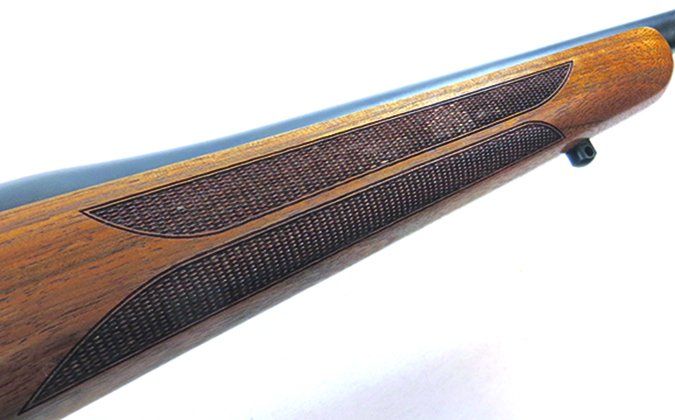
The M12 follows the Mauser bloodline, but with a modern push-feed bolt and other features we have come to expect on currently produced hunting rifles, such as a detachable magazine. Mauser has traditionally named rifle models after the year of development. The M12 was developed in 2012. The Blaser Group owns Mauser as well as Blaser and JP Sauer, with manufacturing facilities in Isny, Germany. Rifles are imported into the U.S. by Blaser-USA in San Antonio, Texas. We suspect the rifle was designed with the push-feed bolt to reduce manufacturing costs and to build a rifle for medium to big-game hunting, not including dangerous game. Blaser also shares components between rifle brands. In fact the Sauer Model 101 and M12 share some components like the barrel, trigger, 60-degree bolt lift, detachable magazine, and six locking lugs.
The M12 was stocked with Grade 2 walnut and wore a matte-blued metal finish. Other models feature synthetic or higher-grade-wood stocks. We thought that the metal finish was well executed. The glossy wood stock features an American-style straight comb and a nicely contoured cheek piece with a rubber recoil pad that gives the rifle a 14.4-inch length of pull. Pad to stock fit was perfect. The pistol grip was fitted with a cap. We liked the pistol grip because it was open and thin, allowing for fast handling. The checkering was machine cut, and most of our team would have preferred a traditional diamond pattern like Mauser uses on the M03 and M98 rifles.
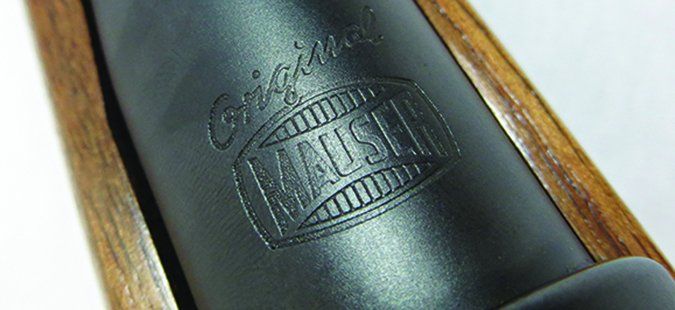
In hand the M12 easily shouldered and felt lithe, for the most part, except where the detachable magazine is located. It is chunkier at that point, and some testers noted they carry their hunting rifle at that balance point and would have liked it a bit thinner. The nice lines of the rifle really hide that bit of girth. Weighing only 6.7 pounds unscoped, the M12 handled fast even fully set up.
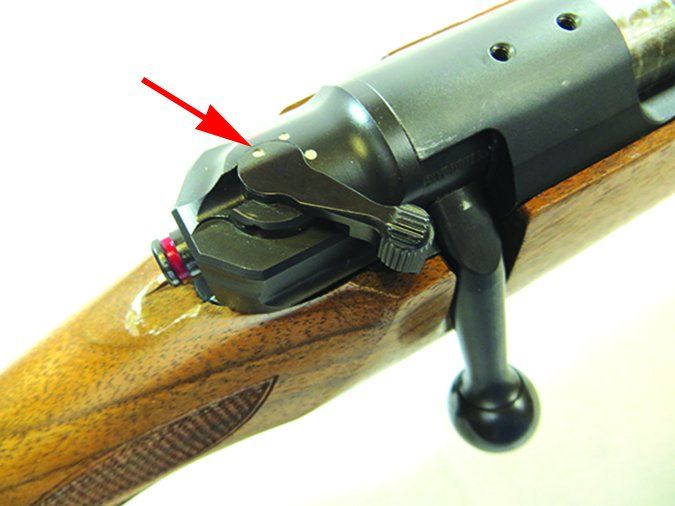
The 22-inch barrel is hammer forged and tapered. It is press fit into the receiver, not screwed in like a traditional Mauser. The barrel free floats, and the muzzle is crowned. The bolt is nicely jeweled and employs six locking lugs, so the bolt lift is 60 degrees, which means there is room between the bolt knob and the scope’s eyepiece, so your fingers do not get jammed. The rifle cocks upon opening the bolt and uses twin plunger-type ejectors. A red-ringed cocking indicator protrudes from the rear of the bolt, informing the user the rifle is cocked.
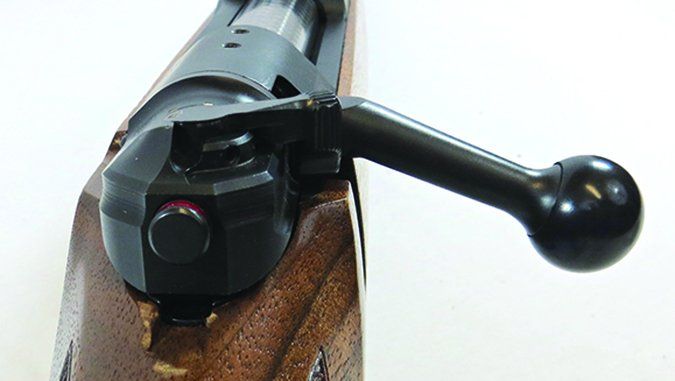
The action is open at the top like more-traditional bolt action rifles. Modern-design receivers like the Ruger American, Savage Axis, Tika T3, and others leave more metal on top to keep the receiver rigid. A rigid receiver enhances accuracy. The receiver is drilled and tapped, and we used a one piece Picatinny rail to mount an optic.
A three-position safety is located on the back of the bolt, offering easy access for right-handed shooters. It operates quietly, which we liked. In the forward position, the rifle is ready to fire; in the middle position, the trigger and sear are locked, but the bolt can be cycled; and in the rear position, the bolt handle and trigger are locked. The floor plate holds a detachable polymer box magazine, which we found easy to load and snap into place. The magazine release is just forward of the floor plate and inset into the stock. The magazine can be detached for reloading or it can be reloaded from the top through the receiver. We could also load single rounds, which is a feature we liked. The trigger isn’t adjustable. Ours required only 1.9 pounds of pressure to release, so while we liked the trigger as delivered, we would have welcomed the opportunity to adjust the trigger ourselves. We felt that around 2 pounds, the trigger was spot on, crisp, and clean.
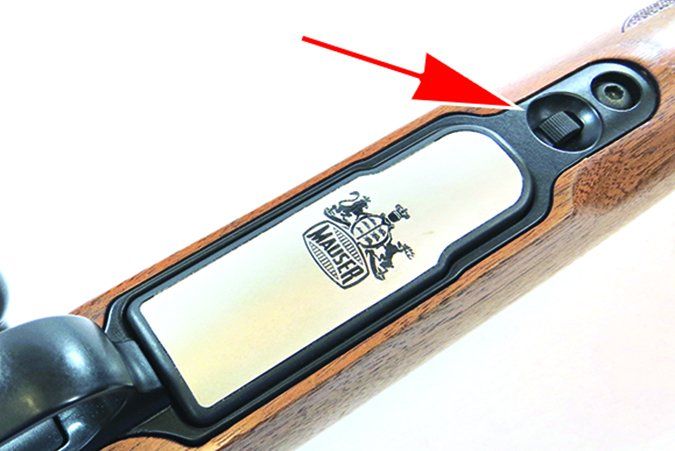
The bolt handle is bent straight down with the knob close to the stock and just above the middle of your trigger finger. Follow-up shots are relatively fast, but not as fast as with the Blaser. With the Mauser, as your finger comes off the trigger, it is in position to lift the bolt and cock the rifle, then the shooter may cycle the bolt to eject and chamber a fresh round. We found operating the bolt this way to be fast and efficient.
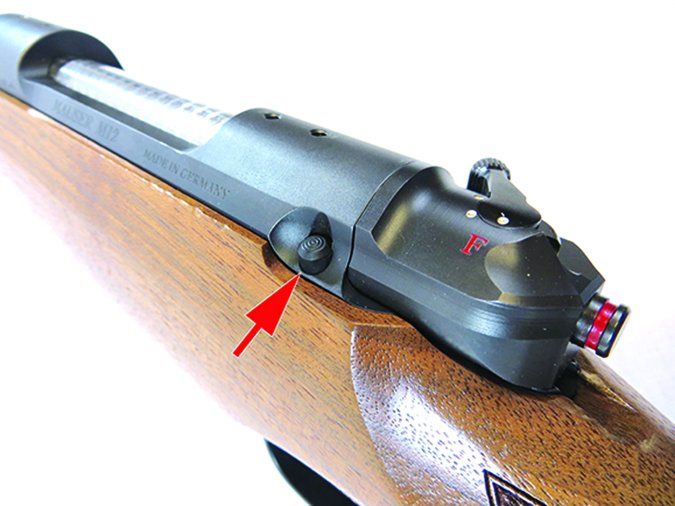
At the range and using a rest, we fired for accuracy at 100 yards and found the M12 readily produced excellent accuracy. With Hornady Full Boar ammo loaded with a 165-grain GMX bullet, we were able to shoot a 0.32-inch three-shot group. The M12 liked all the ammo we fired through it. We had absolutely no issues with the rifle. On average, we were easily able to get 1-minute-of-angle accuracy out of the rifle. It was easy to see why this rifle was expensive in the way it was finished and the smoothness of the bolt operation. We tried to trip up the ejector by slowing pulling back the bolt, but M12 effectively ejected empties every time. Recoil was tolerable, and because this is designed for hunting, rifle rounds fired will be limited. We give a lot of credit to the crisp trigger for the accuracy we achieved. Disassembly was straightforward. Press the bolt release, and the bolt comes free.
Our Team Said: The M12 is reliable, accurate, and well-built. This rifle puts an actual Mauser-made rifle within reach of the average hunter, and if you want to add a Mauser rifle to your gun safe, this is a good choice. If the Mauser name doesn’t have panache for you, there are other wood-stock blued rifles less expensive but just as capable.
Blaser R8 Professional 30-06 Springfield, $3787
GUN TESTS GRADE: A-

The R8 was pricey, but it offered interchangeable barrels, a safe firing system, fast follow-up shots, and good accuracy.
| ACTION TYPE | Straight pull bolt |
| OVERALL LENGTH | 40.6 in. |
| BARREL LENGTH | 23 in. |
| SIGHTS | None, optics ready |
| OVERALL HEIGHT (w/o scope) | 6.6 in. |
| STOCK LENGTH OF PULL | 14.75 in. |
| WEIGHT UNLOADED | 7.4 lbs. |
| WEIGHT LOADED | 7.6 lbs. |
| CAPACITY | 4+1 |
| ACTION FINISH | Matte black |
| BARREL FINISH | Matte black |
| MAGAZINE TYPE | Detatchable polymer box |
| STOCK | Synthetic, dark green |
| TRIGGER PULL WEIGHT | 2.2 lbs., single stage |
| SAFETY | Decocking button |
| ACCURACY GUARANTEE | None stated |
| WARRANTY | 10 years |
| TELEPHONE | (210) 377-2527 |
| WEBSITE | Blaser-USA.com |
| MADE IN | Germany |
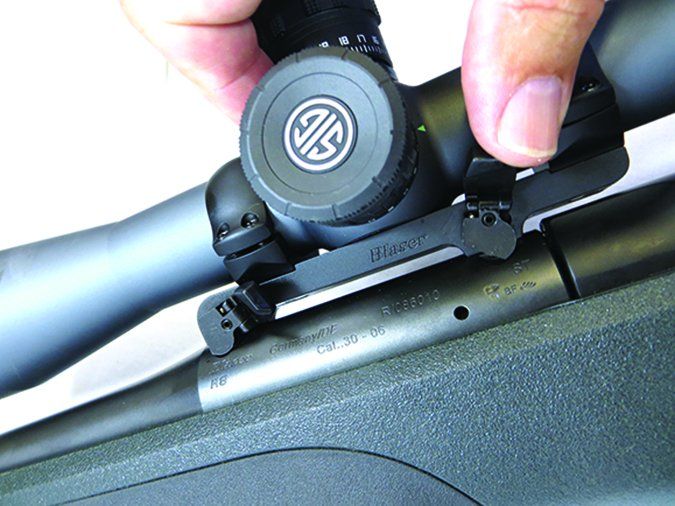
The Blaser R8 Professional is pricey, but it allows owners to interchange barrels, so you can shoot prairie dogs or pachyderms with the same rifle. One team member said that for the money, he’d buy two inexpensive rifles with scopes, and still have money left over for plenty of ammo. Getting beyond the price, we found the R8 to be quite capable, unique, and easy to use.
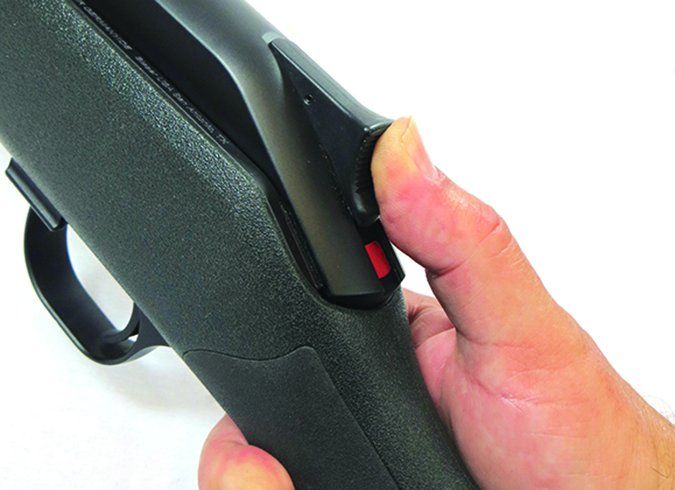
The R8 was designed in 2008, evolving from Blaser’s Model R93, and uses a straight-pull bolt that is much easier to operate from the shoulder than a traditional turn-bolt action like the Mauser M12. The bolt operates with a flick of the wrist, allowing the shooter to keep his sight picture for faster follow up shots compared to a traditional bolt. Testers quickly warmed up to the straight-pull bolt after only running a few rounds through the rifle.
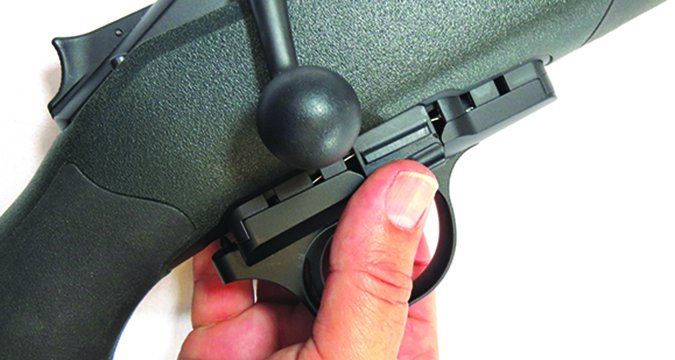
The bolt is designed with a radial head. Basically, a collet behind the bolt-head is slotted into 13 pieces. As the bolt is closed, the collet is pushed forward against the rear of the bolt head, causing the front ridge to expand into a groove in the barrel, thus locking the bolt to the barrel a full 360 degrees. This straight-pull action also makes the rifle 3 inches shorter than a traditional turn bolt while still having the same barrel length. The team liked the balance of the R8 and thought it was very nimble and fast pointing.
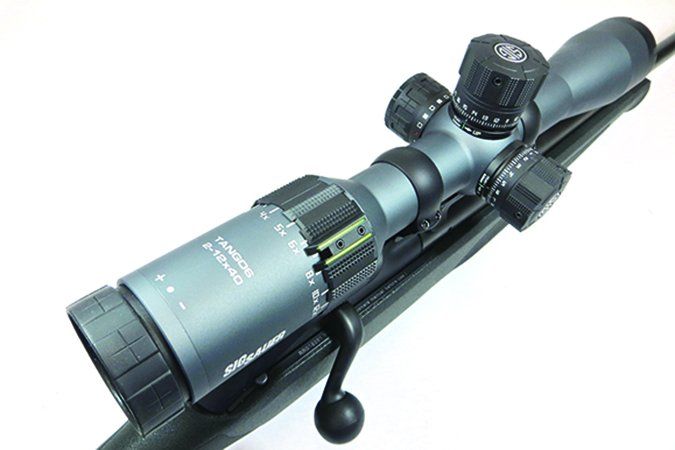
The cocking slide/safety slide is unique to the Blaser R8 rifle. Essentially, it cocks and de-cocks the rifle. Use your thumb to push the cocking slide forward, and it will lock in place, exposing a red square which indicates the rifle is cocked and ready to fire. To decock the rifle, press the slider forward and down and the cocking slide returns back. With the slide in the rear position, the bolt is locked in place. If you want to open the bolt, you can push the slide to the cocked position or slightly press the slide and pull back on the bolt handle. This system has been proven to be very safe with the R93 model. We felt the cocking slide acted like a safety, but went further to decock the rifle, which makes the rifle even safer in use. We liked the ability to decock the rifle without pulling the trigger. In the decocked position, the rifle will not discharge even if dropped.
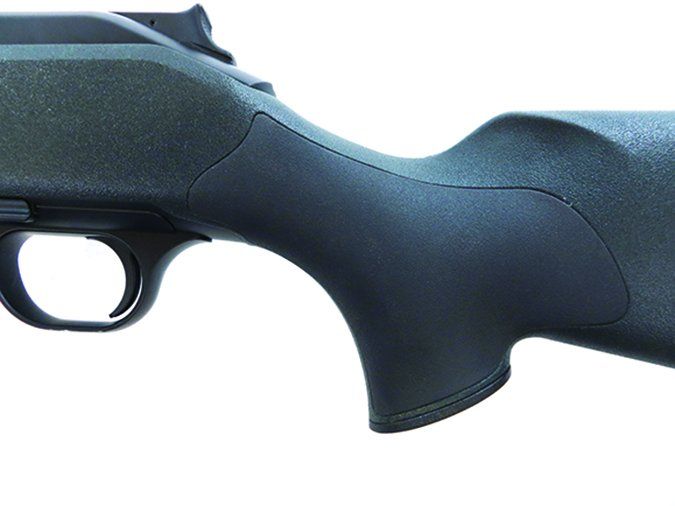
The R8 is offered in a variety of configurations, with synthetic or wood stocks. The R8 could be had as ornate or plain as one desires or budget dictates. The R8 Professional features a one-piece synthetic stock and a matte-black finish on the metal. The finish was excellent. Overall, the polymer stock had a smooth textured finish that offered no glare and the gripping areas of the stock were soft and rubbery offering a comfortable grip. The pistol grip area was tighter than the Mauser, which some big-handed testers noted was not as comfortable. A black synthetic forend cap and black recoil pad completed the stock. Like the Mauser, the comb was straight.
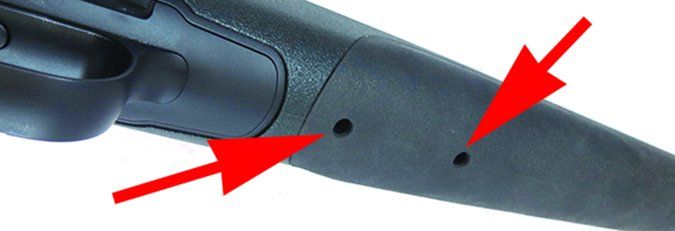
A detachable magazine is not that unique — except the R8 uses it as an additional safety device. The magazine and trigger eject as one piece from the bottom of the receiver, essentially disabling the rifle from firing while allowing the magazine to be loaded. Two tabs, one on each side of the receiver, need to be pressed at the same time to remove the magazine, so an accidental magazine dump would be an exception. The magazine can also be locked into the receiver and loaded from the top like a traditional internal box magazine. We had plenty of room to load through the ejection port. You can also load one round at a time. If the magazine/trigger group is removed from the rifle while the rifle is cocked, the rifle automatically de-cocks when the magazine is removed. The trigger pull averaged a crisp 2.75 pounds, and though it was not adjustable, we felt it was excellent for hunting.
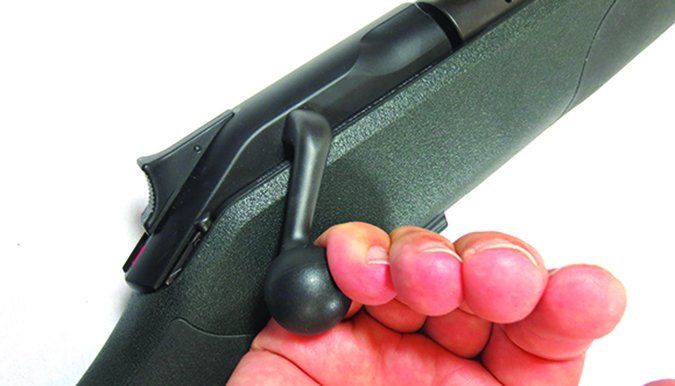
The R8 also allows owners to swap barrels and change calibers. The barrels are hammer forged and attach to the stock via two screws. A 5mm hex wrench tool is included with the rifle to attach a barrel. We only tested the 30-06 barrel with the rifle, but we could swap out to a smaller or larger caliber by replacing the barrel, bolt head, and magazine insert that correspond to the same caliber group. Blaser divides calibers into six groups, all of which have distinct markings, so making a caliber change should be nearly foolproof. We felt the ability to swap calibers made the R8 versatile. An extra barrel assembly cost about $1000.
The Blaser scope saddle mount ($425; Eurooptic.com) is also unique and uses a one-piece mount that clamps into dimples cut into the barrel. The mount allows for quick removal, and as advertised, we saw no loss of zero at 100 yards.
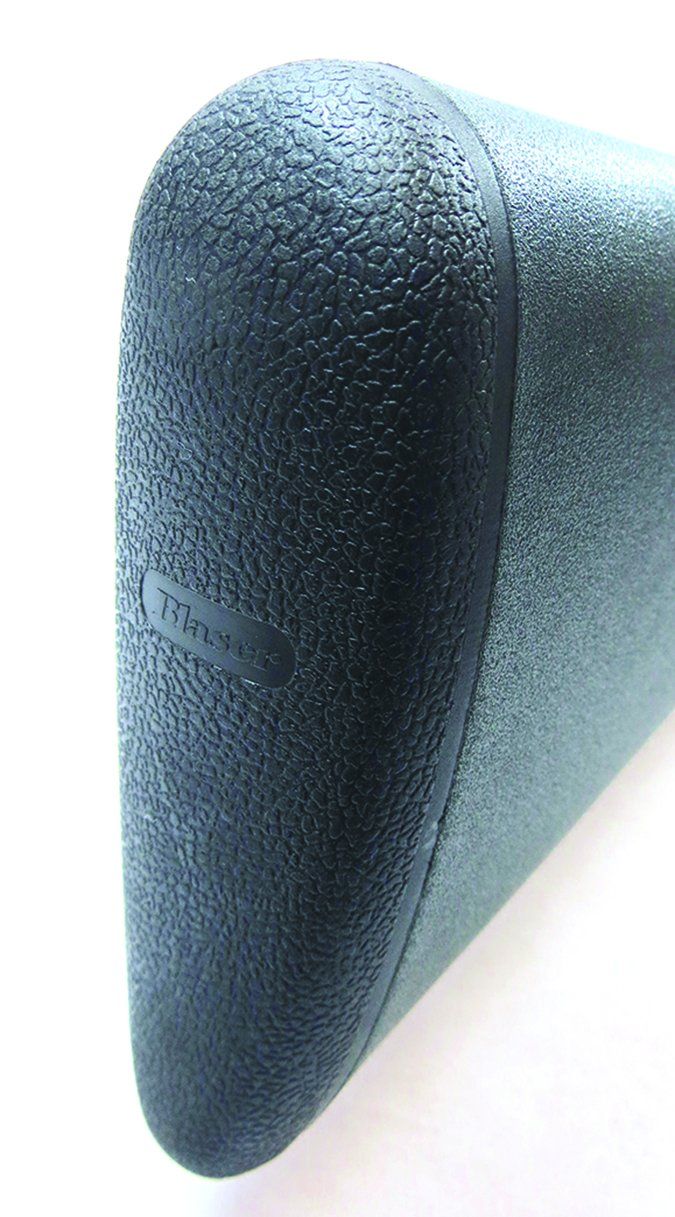
Innovative and unique might not translate to performance, but we found the R8 could be run and relied on for accuracy and fast follow-up shots. Our best three-shot group at 100 yards was 0.65 inches with Black Hills Gold loaded with 180-grain Nosler AccuBond bullets. The crisp tigger helped us achieve that accuracy. We did a double take, since two of the bullets went through the same hole. With Hornady Full Boar ammo, we averaged 1.5-inch groups, and the rifle shot noticeably better with American Whitetail. Recoil was noticeable due to the rifle’s light weight but we thought it was tolerable due to the design of the stock.
Our Team Said: The cost of the R8 was extremely high, but the rifle offers unique features that make it safer in the field. Accuracy was excellent, and the ability to swap barrels and calibers made this rifle more appealing.
Written and photographed by Robert Sadowski, using evaluations from Gun Tests team testers.



























